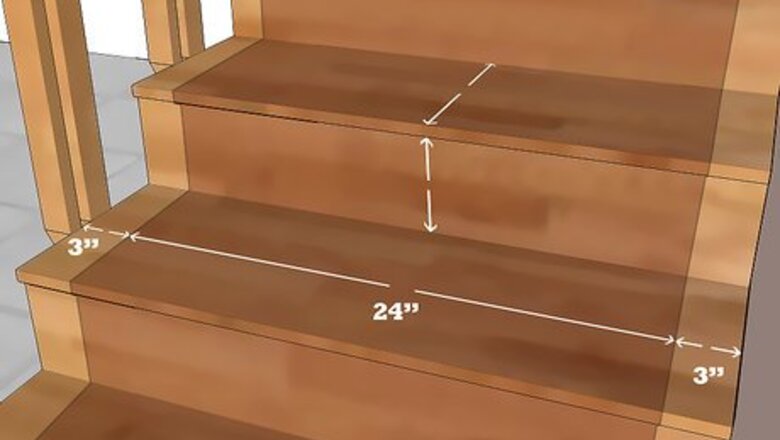
views
Making Preparations
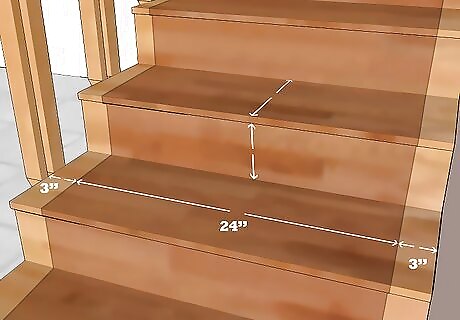
Measure your staircase. Before you do anything else, you'll need to have a clear idea what the size of your staircase is. The includes the length, width and height of each stair, as well as the number of stairs itself. In most cases, the number of steps is the most important trait to know and the easiest to figure out, as it will let you know how many sets of tackless strips and pads you'll need for your carpet. The standard stair is 30 inches wide. If your stairs follow the standard dimensions, it will be much easier to measure and lay your carpet, as carpet runners designed for the standard dimensions will be easy to find. Assuming you have standard-sized stairs, and allowing for 3 inches on either side to display the wood, you need 24 inches for each stair step and riser. Rise (height) and runs (width) can vary in size, so be sure to measure closely. An easy calculation is multiplying the number of stairs by the individual step's width and height. Then divide the answer by 12 to find the square footage.

Meet with a carpet sales professional. Before moving into the practical stage of setting the carpet, you should go out and consult with a sale associate who specializes in carpets. Talk to him about your project, specifically the size and scope, and the general expectation you might have for an end result. Chances are this associate will be able to lend you some specific and helpful advice, as well as point you in the direction of some carpet types that might suit your goals. Consider taking pictures of your stairs as they are to give the sales associate a kind of visual references to keep in mind while he helps you. If you are trying to calculate the amount of carpet material you'll need from the sales associate, remember to keep the stair's nose (or rounded front-section) in mind, giving a couple more inches than you would otherwise to compensate for it.

Consider the aesthetic design of your planned staircase. At the end of the day, laying a carpet runner along your stairs adds comfort and purpose, so it's good to keep your creative side in mind while making your stair decisions. Choosing to carpet just the step and not the riser, as well as different widths (leaving wood visible on either side, for example), colors, and textures will yield different results for your stairs and home. Some carpet designs come with a design woven into it. If this is the case, you'll want to respect the properties of the design pattern while placing the carpet. Ideally, you should aim to give the staircase as much visible symmetry as possible. This may make working with patterning irregularly-sized staircases very tricky, as most carpet runners are made to fit a certain kind of stair.
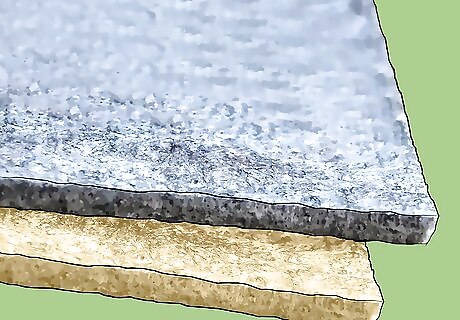
Purchase the necessary supplies. The most important ingredient you'll need in your home improvement concoction is obvious the carpet runner itself. Unless you've already calculated an accurate measurement of how much you'll need (keeping the height and noses in mind), you should go by the word of the carpet professional helping you. If you do not have the necessarily supplies yet, the following is a list of things you'll almost certainly need: As much carpet as is required to fit the stairs, leaving an extra couple of feet to account for cuts and possible errors. Tackless strips to hold the carpet and padding down. You'll need at least three for each step. An industrial stapler and staples, for securing the carpet. A hammer and nails. Two strips of padding for each step -- one of the step itself, and one for the rise. A carpet knee-kicker, to help stretch and fasten carpets. With stairs you want to stretch it into the inner corner of each step.
Installing Tackless Strips
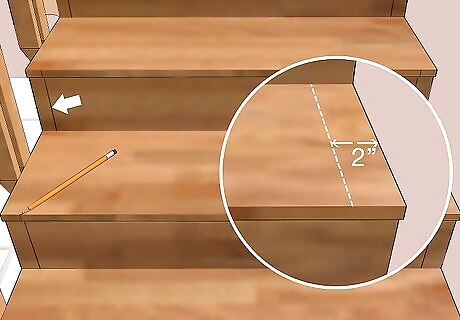
Outline where you want the carpet to go. Measure two inches on either side from the stair tread and trace straight lines from the front to back of the stair. This will give you a visual outline of where to place the tackless strips and the carpet itself, when the times comes. You can mark your outline in blue masking tape for nice lines, then simply peel it off when you are finished.
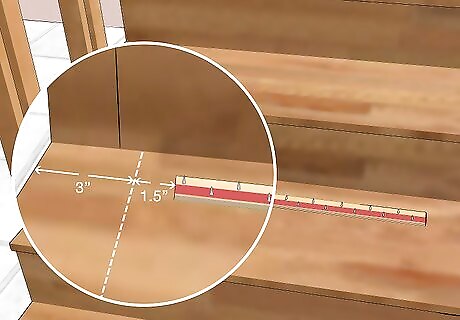
Cut your tackless strips. Tackless strips are what keep your carpet rooted to the ground. Cut them 1.5 inches narrower than the width of the steps to be carpeted. This will make sure you don't get any misplaced strips protruding once the carpet is set. For example, if the stair is 30 inches wide, your carpet runner will measure 26 inches wide, so your tackless trips must measure 24.5 inches wide. Carpet tackless strips are almost always strips of Douglas fir wood, usually 4 feet long by 1 inch wide, with very sharp nails protruding through them at 60 degree angles and tacks or brads partially sunk in the strip.
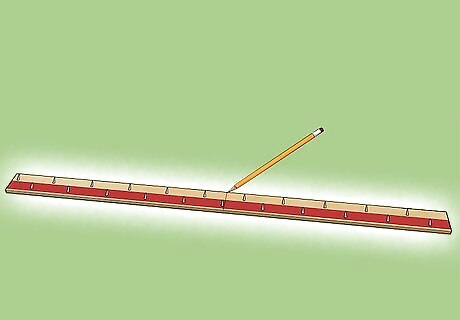
Find the center of each tackless strip and step, and draw lines in pencil. Having a visual cue as to the true center of your tackless strips will make them easier to accurately place upon each step. Next, do the same for the steps themselves. Use a ruler or meter stick for each. As always, an HB pencil is best for this, as the line will be clear and visible.
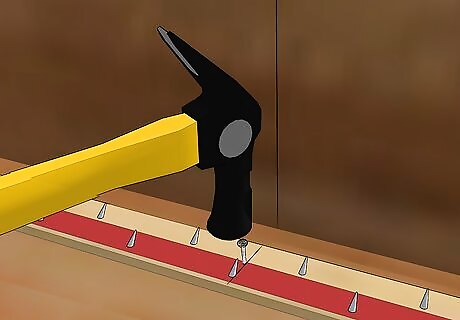
Hammer the strips into place. Align each tackless strip centre line to the line on each itself. With the strips now where you want them, it's time to nail them in for good. Hammer several tack nails to each strip, and be sure to evenly dispersed throughout the length of the strip. This will make sure it has the highest possible stability. One or two strips per step is enough, so long as you leave a strip for the height of each step to install horizontally. Install one for now, closer to the rise; that way, you'll have an easier time gauging the center for the horizontal strips.

Install a horizontal strip for the height of each step. Adding another set of tackless strips to the heights of the steps will make the carpet fit far more snugly into the frame of the stairs. Add them to the centre and evenly disperse 3-5 nails along each of them. With the tread strips in place it will be much easier to properly aim and gauge the center,
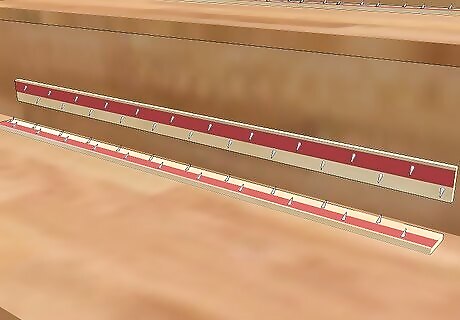
Add another set of strips for the other side of each step. The third and final set of strips should be much easier to work on now that you're used to it. While it seems like it would make most sense to do this third set when you did the first, it's good form to give yourself stepping room for installing the horizontal strip, so it's good to leave this one for last. Work your way from the top to the bottom. That way, you'll maximize the stepping space and comfort you are afforded while you work.
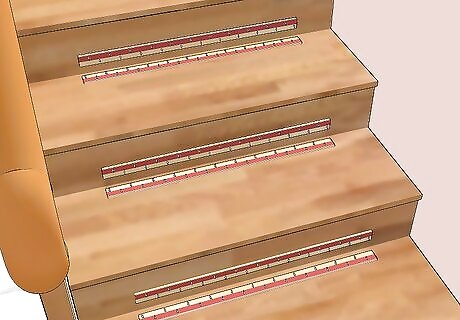
Ensure every stair has been given properly centered strips. Before you move on to the padding and carpet laying, you should verify your progress there isn't anything you have overlooked or erred on while working. It will be far more difficult to fix if you realize you have to fix something a few steps down the road.
Setting the Carpet Padding
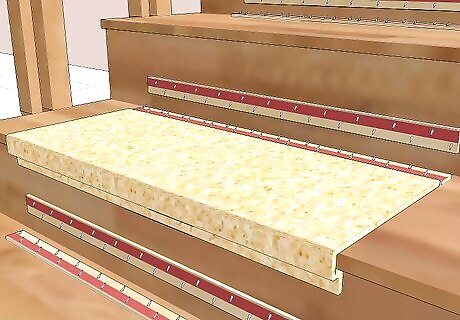
Measure and cut a piece of carpet pad for each tread. Carpet pad is what gives the carpet it's pleasant feeling of cushion and softness, as well as protecting feet from possibly protruding tacks. Cut every piece to be the same length as the tackless strips, not the carpet runner itself. This will give the carpet a nice tapered end on either side when it's done.
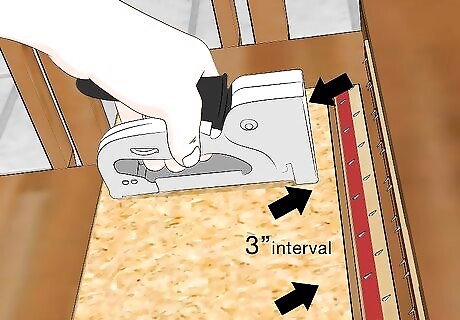
Lay your padding sheets flush against the tackless strips and staple them securely. With all of your pieces ready, it's time to put them in place. Lay each sheet of padding down and take care to align it properly with the tackless strips. Apply industrial staples at three inch intervals throughout the length of it. This time, it's a good idea to start from the bottom and work slowly up. That way, you'll be able to stand firmly on the padding while you're stapling subsequent steps.
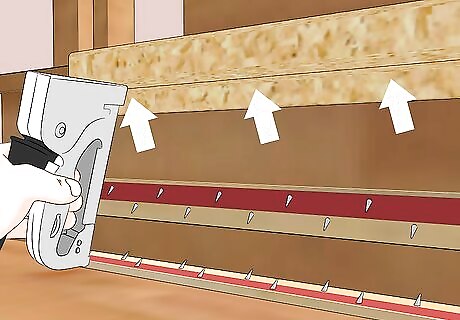
Pull the padding snugly over the stair nosing and staple every three inches. Taking the stair padding and tuck it under the nose of the step. Horizontal padding should be easier to accomplish now that you have the basics handled. Try to line up the staples on the heights' padding with the ones you've made for the treads. The nose is the part of the step that extends slightly past the drop, or height. The height, then, is the vertical part of the step.
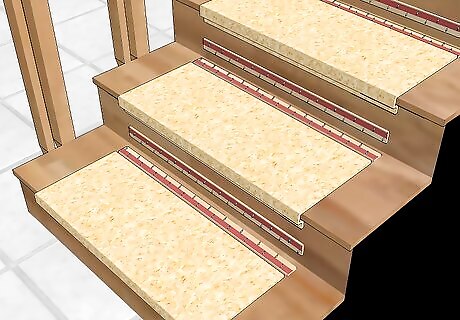
Verify the padding has been done correctly. At this point, you shouldn't see any more of the tackless strips. They should be covered instead by the padding, both on the treads of the steps and the heights. All of this will be virtually invisible when it finally comes time to lay the carpet runner, but a single mistake here could make future steps impossible, so it's imperative you fix any potential issues before getting around to the carpet. If you're satisfied with your current work however, you may begin laying the runner.
Laying the Carpet Runner
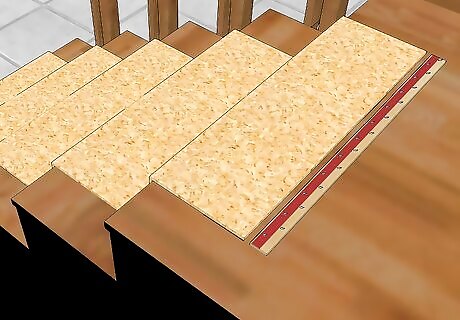
Start at the top of the staircase. When it finally comes time to lay your carpet runner, it's best to start at the very top and work your way down. That way, you'll have gravity on your side, and it'll be much easier to cut any runoff carpet at the end.
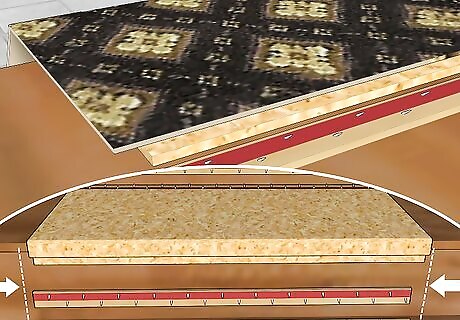
Place runner between layout pencil marks. If you traced the carpet outline at the beginning of the project, it should be an easy matter of getting the carpet situation between the two as close as you can. Take care to press the carpet under the nose and tug the rest out to make sure you're getting just as much carpet as you need. Work down to the last step; when you're done, the carpet should be covering the expected ground, but the outline of the steps may not be fully visible. Make sure each step is as good as it can get before you move down to the next-- any mistake will cause a load of undue strain later on once the project is supposedly complete.
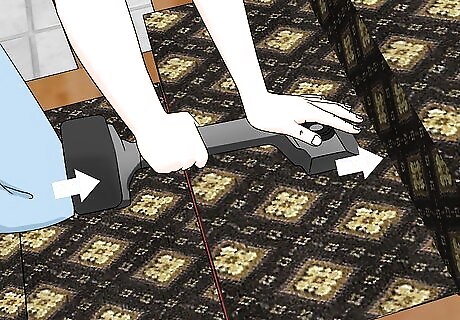
Press your carpet into the outline of the steps with a carpet knee-kicker. A carpet knee-kicker will get the carpet planted firmly in areas that may be otherwise difficult to reach. Place the front edge of your carpet knee-kicker on center of the runner about two inches from the riser and apply pressure until the carpet is locked in. They can be remarkably satisfying to use, and will give your stairs a much tighter look than if done without. Lean on the front knob of the kicker with one hand, and use the other hand to keep the kicker's shaft level. You can also use a carpet chisel. The dull edge helps tighten up corners and is easier to use on stairs or in tight quarters.
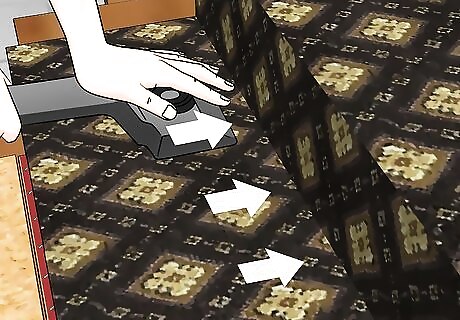
Verify the kicking is complete once you're done. As with previous steps, the last part of using the knee-kicker should be making sure you got the job done to your satisfaction. Without kicking in properly, you may have too much carpet or too little, and it'll require uprooting or even destroying the progress you've made.
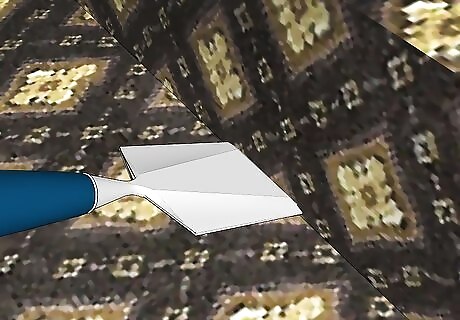
Verify your work is correct. Before you move on, you should ensure that the carpet is being snagged by the tackless strip at the far end of the tread. If the tackless strips aren't properly clinging to the carpet, it could result in the carpet getting bumpy a few years down the road. Using a chisel or other thin tool, press the angle between the step's height and tread to make sure it's getting hooked in.
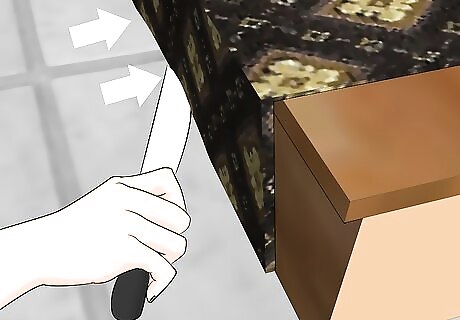
Carefully cut any excess carpet at the bottom of the steps. At the bottom, there should be a little bit of runoff. From here, it's just a simple matter of cutting the excess carpet away with a carpet knife. Feel free to do what you will with the remainder of the carpet. Some people are quick to throw them out, while others like to find practical uses for them.
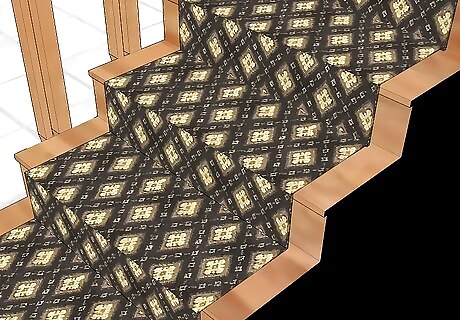
Staple each step through to the wood. Having a powerful stapler designed for home improvement is necessary to finish things off and get your carpet snug and perfect. When stapling, push stapler through the carpet pile and against the backing before pulling the trigger. Staple on the underside of the step noses, and nearest the angle between the tread and height. Staple at three inch intervals for optimal stability. Alternatively, you can use carpet glue instead of staples. Make absolutely certain that the carpet is exactly where you want it to be before you staple. After you staple, it will be next to impossible to correct any mistakes.

















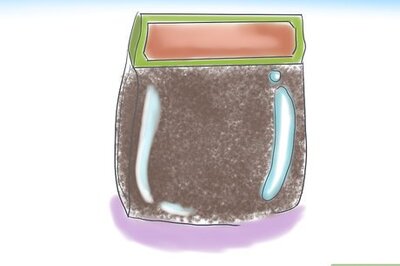


Comments
0 comment